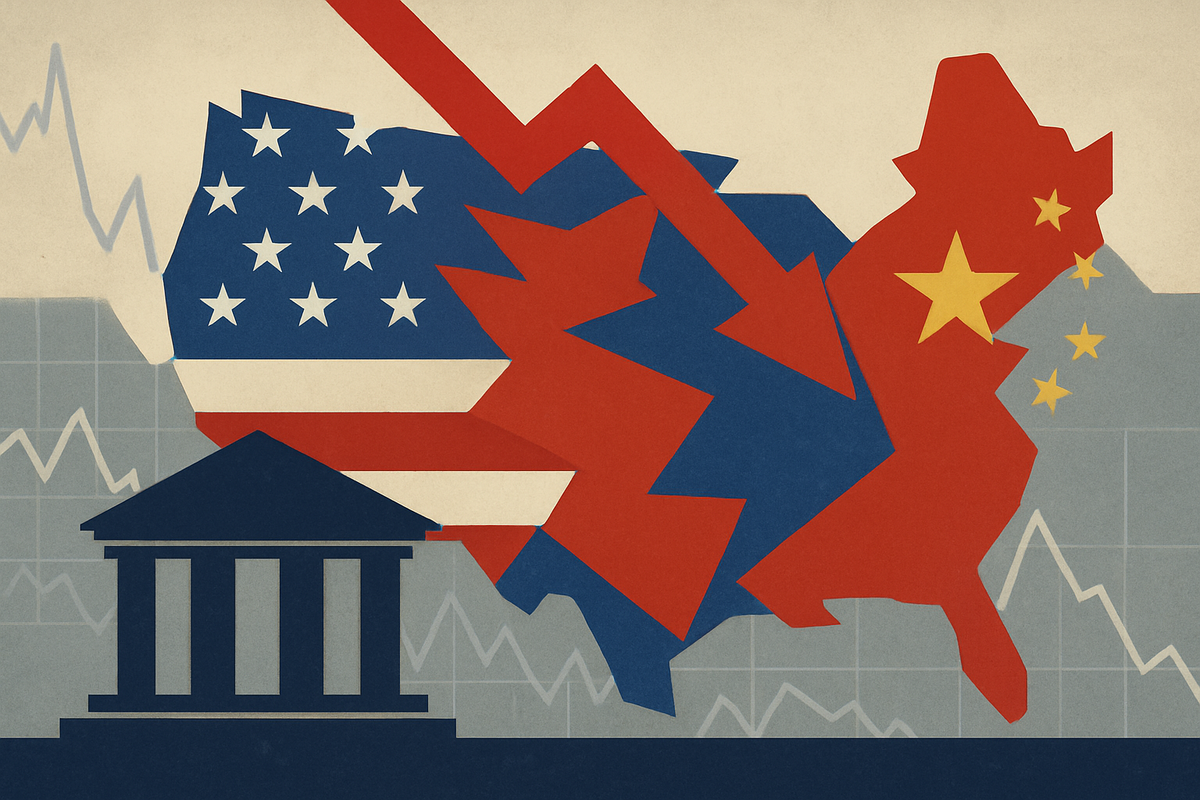
WASHINGTON D.C. – October 15, 2025 – Federal Reserve Governor Stephen Miran has issued a stark warning, advocating for an urgent and more aggressive series of interest rate cuts to inoculate the U.S. economy against the escalating fallout from renewed trade hostilities with China. His call comes at a critical juncture, as heightened U.S.-China trade tensions, including China's recent restrictions on rare earth material exports, cast a long shadow over global growth prospects, intensifying an already complex economic landscape marked by a softening labor market and an ongoing U.S. government shutdown.
Miran's bold proposal for an additional 1.25 percentage points in rate reductions, beyond the quarter-point cut implemented in September, signals a growing internal debate within the Federal Reserve. His stance underscores a recognition that the current monetary policy, which he describes as "quite restrictive," leaves the economy vulnerable to significant shocks, particularly those emanating from geopolitical friction. The immediate implication is a potential shift towards a more dovish monetary policy, aimed at stimulating demand and investment to counteract the deflationary and stagflationary pressures of a looming trade war. However, such a move also carries the risk of reigniting inflation, presenting a delicate balancing act for policymakers.
Miran's Urgent Plea: A Deep Dive into the Fed's Dilemma
Governor Stephen Miran's impassioned plea for urgent interest rate cuts has become a focal point in the Federal Reserve's ongoing deliberations. Speaking recently, Miran emphasized that the renewed trade tensions with China, particularly Beijing's strategic move to restrict access to crucial rare earth materials, represent a significant and immediate downside risk to the U.S. economic outlook. He argued that the existing quarter-point reduction approved by the Federal Open Market Committee (FOMC) in September 2025 is insufficient to cushion the economy from these gathering headwinds, advocating for a substantial 1.25 percentage point cut on top of the initial reduction. Miran's core belief is that current monetary policy is "quite restrictive," leaving the economy susceptible to external shocks at a time of heightened global uncertainty.
The timeline leading up to this moment reveals a rapidly evolving economic picture. The Fed had already initiated an easing cycle in September 2025 with a quarter-point rate cut, primarily in response to a weakening labor market. However, the subsequent escalation in U.S.-China trade tensions, including Washington's threats of 100% tariffs on a broader range of Chinese imports and Beijing's retaliatory measures concerning rare earth exports, has introduced a new, more urgent dimension to the policy debate. While Federal Reserve Chair Jerome Powell has also signaled a willingness for further rate cuts, primarily citing labor market softness, Miran's direct and aggressive linkage of cuts to trade tensions distinguishes his position. The FOMC is widely anticipated to approve another quarter-point reduction at its late October meeting, but Miran's call pushes for a far more decisive intervention.
Key players in this unfolding drama include Governor Stephen Miran, who is emerging as a leading dovish voice; Federal Reserve Chair Jerome Powell, who navigates the broader consensus; and the entire Federal Open Market Committee, tasked with steering monetary policy. The backdrop is further complicated by an ongoing U.S. government shutdown in October 2025, which has created a "data vacuum," delaying crucial economic indicators and forcing the Fed to make critical decisions with incomplete information. This uncertainty has already contributed to market volatility, with investors closely watching for any signals of the Fed's next move and the trajectory of U.S.-China relations.
Navigating the Trade Winds: Winners and Losers in a Lower-Rate Environment
A significant interest rate cut, as proposed by Governor Miran, would reverberate across various sectors of the U.S. economy, creating both winners and losers, particularly when juxtaposed with the ongoing U.S.-China trade tensions. Companies heavily reliant on borrowing for expansion or operations stand to benefit significantly. The housing market, for instance, could see a boost as lower interest rates translate to cheaper mortgages, potentially stimulating demand for homebuilders like D.R. Horton (NYSE: DHI) and mortgage lenders such as Wells Fargo (NYSE: WFC). Similarly, consumer discretionary sectors, including auto manufacturers like General Motors (NYSE: GM) and retailers, could experience increased sales as consumers face lower financing costs for big-ticket items. Highly leveraged growth companies, often found in the technology sector, could also see their borrowing costs reduced, potentially supporting investment and innovation.
Conversely, the escalating U.S.-China trade tensions present a formidable challenge to numerous industries. Companies with extensive supply chains in China or those heavily dependent on Chinese markets for sales could face significant headwinds. For example, Apple (NASDAQ: AAPL), with its vast manufacturing presence in China, could see disruptions and increased costs due to tariffs or restrictions. Manufacturers that rely on imported intermediate goods, particularly those using rare earth minerals, would be directly impacted by China's export restrictions. This could affect industries from electronics to renewable energy, potentially harming companies like Tesla (NASDAQ: TSLA) if critical battery components are affected. Furthermore, agricultural exporters, such as Archer-Daniels-Midland (NYSE: ADM), which have historically faced retaliatory tariffs from China, could continue to suffer from reduced demand.
While interest rate cuts aim to mitigate the economic slowdown caused by trade tensions, they cannot fully insulate companies from the direct impact of tariffs, supply chain disruptions, or reduced access to key materials. The proposed cuts could provide a much-needed lifeline by reducing the cost of capital, allowing some businesses to weather the storm more effectively or invest in diversifying their supply chains. However, for companies deeply enmeshed in the U.S.-China economic relationship, the underlying trade friction remains a dominant factor influencing their profitability and operational stability, even in a lower interest rate environment.
Wider Significance: A Precedent-Setting Moment for Monetary Policy
Governor Miran's urgent call for aggressive interest rate cuts in response to U.S.-China trade tensions marks a potentially precedent-setting moment for Federal Reserve monetary policy. It highlights the increasingly complex interplay between geopolitical events and domestic economic stability, pushing the Fed to consider tools beyond traditional inflation and employment metrics. This event fits into a broader industry trend where central banks globally are grappling with the limitations of conventional monetary policy in an era of supply-side shocks and geopolitical fragmentation. The risk of "stagflation" – a scenario where high inflation coexists with economic stagnation – looms large, as tariffs can simultaneously increase prices and depress economic activity.
The ripple effects of such a move would extend far beyond U.S. borders. A more dovish Fed, aggressively cutting rates, would likely put downward pressure on the U.S. dollar, impacting global trade flows and potentially influencing other central banks to adjust their own policies to maintain competitive exchange rates. Countries with significant trade ties to the U.S. and China would closely monitor these developments, as their own economies could be caught in the crossfire of a trade war cushioned by U.S. monetary easing. For example, European economies, with their strong export focus, could face both opportunities from a weaker dollar and challenges from a global trade slowdown.
Regulatory and policy implications are also significant. The ongoing U.S. government shutdown in October 2025 exacerbates the challenge, forcing the Fed to make critical policy decisions in a "data vacuum." This lack of timely economic data intensifies the internal struggle over the appropriate policy path and underscores the need for robust institutional frameworks to manage economic uncertainty. Historically, central banks have often responded to external shocks with monetary easing, but the specific combination of trade-induced stagflationary pressures and supply chain weaponization (e.g., rare earth restrictions) presents a unique challenge. While there are precedents for rate cuts during periods of economic uncertainty, the direct and explicit link to a specific trade conflict of this magnitude, coupled with critical resource restrictions, is a relatively novel scenario, demanding innovative policy responses.
What Comes Next: Navigating the Crossroads of Policy and Geopolitics
The coming months will be crucial in determining the trajectory of the U.S. economy and financial markets, as the Federal Reserve grapples with Governor Miran's urgent call for rate cuts amidst persistent U.S.-China trade tensions. In the short term, all eyes will be on the Federal Open Market Committee's late October meeting, where another quarter-point reduction is widely anticipated. However, the key question remains whether the Fed will adopt Miran's more aggressive stance, or if Federal Reserve Chair Jerome Powell's more cautious approach, primarily focused on the labor market, will prevail. Continued market volatility is almost certain, driven by every new development in U.S.-China trade negotiations and any further statements from Fed officials.
Looking further ahead, the long-term possibilities hinge on the evolution of the U.S.-China relationship. Should trade tensions de-escalate, the need for aggressive rate cuts might lessen, allowing the Fed to recalibrate its policy. Conversely, a deepening trade war, potentially involving further tariffs or critical resource restrictions, could necessitate even more substantial monetary easing to prevent a severe economic downturn. Businesses will need to consider strategic pivots, such as diversifying supply chains away from China or investing in domestic production, to mitigate future geopolitical risks. This could create market opportunities for logistics companies and domestic manufacturing firms.
For investors, several scenarios could unfold. A rapid and significant rate cut could initially boost equity markets, particularly for growth stocks, as borrowing costs fall. However, the underlying economic uncertainty from trade tensions could cap sustained gains, potentially leading to a flight to safe-haven assets like gold, which has historically seen price increases during periods of economic instability. Bond markets would likely see a rally, with yields on U.S. Treasury notes easing. The U.S. dollar would likely weaken, benefiting U.S. exporters but potentially making imports more expensive. The emergence of new market opportunities in sectors less exposed to global trade friction, or those benefiting from reshoring efforts, will be key to watch.
Comprehensive Wrap-up: A Test of the Fed's Resolve
Governor Stephen Miran's urgent call for aggressive interest rate cuts in the face of escalating U.S.-China trade tensions represents a pivotal moment for the Federal Reserve and the broader financial markets. The key takeaway is the increasing recognition within the Fed that geopolitical risks, specifically trade wars and strategic resource competition, now pose a significant and immediate threat to domestic economic stability, demanding a proactive and robust monetary policy response. This marks a departure from a purely inflation and employment-focused approach, highlighting the intricate web of global factors influencing national economies.
Moving forward, the market will be characterized by heightened uncertainty and volatility, as investors weigh the potential benefits of monetary easing against the very real risks of a protracted trade conflict. The Fed's assessment of the U.S.-China relationship will likely become as critical as its analysis of inflation and employment data. The ongoing U.S. government shutdown further complicates this assessment, forcing the central bank to navigate a "data vacuum" at a time when precise information is paramount.
Investors should closely monitor several key indicators in the coming months. Foremost are the pronouncements and actions of the Federal Reserve, particularly the outcomes of upcoming FOMC meetings and any further statements from key governors like Miran and Chair Powell. Developments in U.S.-China trade negotiations, including any new tariffs or retaliatory measures, will also be critical. Finally, while delayed, any available economic data, especially concerning inflation and the labor market, will provide crucial insights into the effectiveness of current policies and the need for further adjustments. The coming period will truly test the Fed's resolve and its ability to adapt to a rapidly changing global economic order.
This content is intended for informational purposes only and is not financial advice






